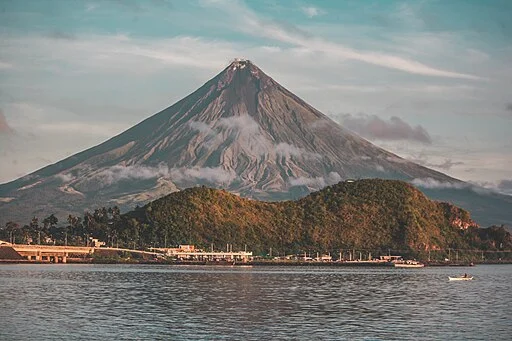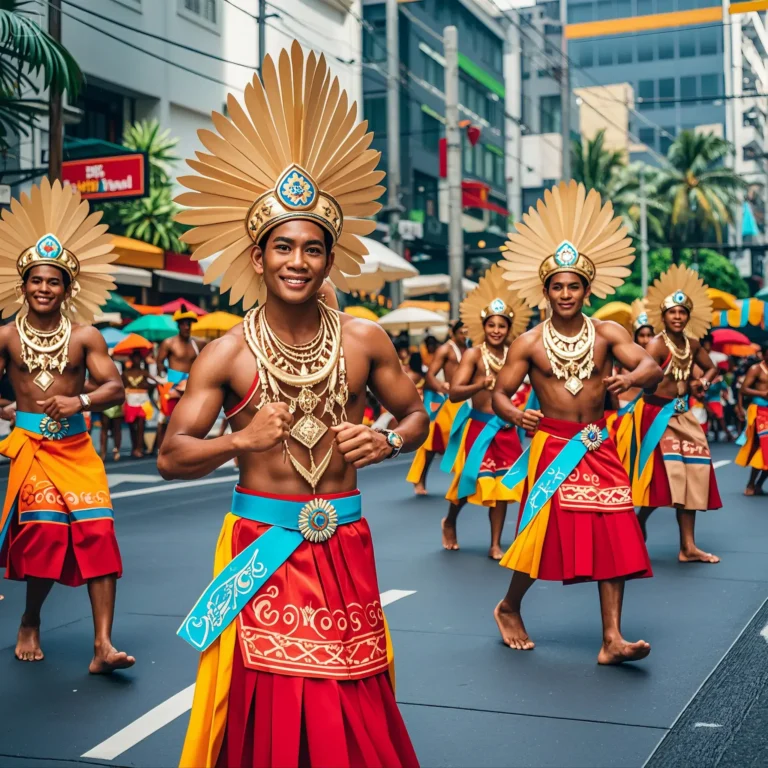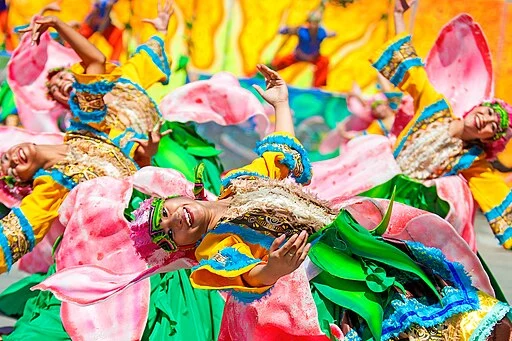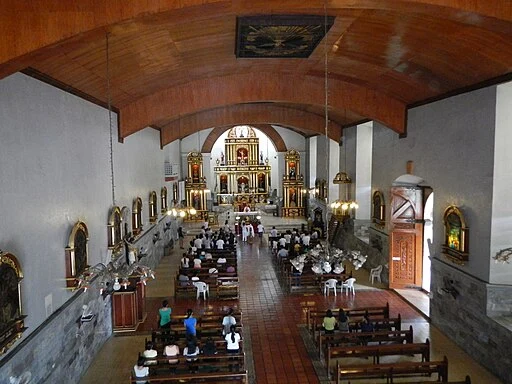13 Historic Filipino Forts: A Journey Through Time
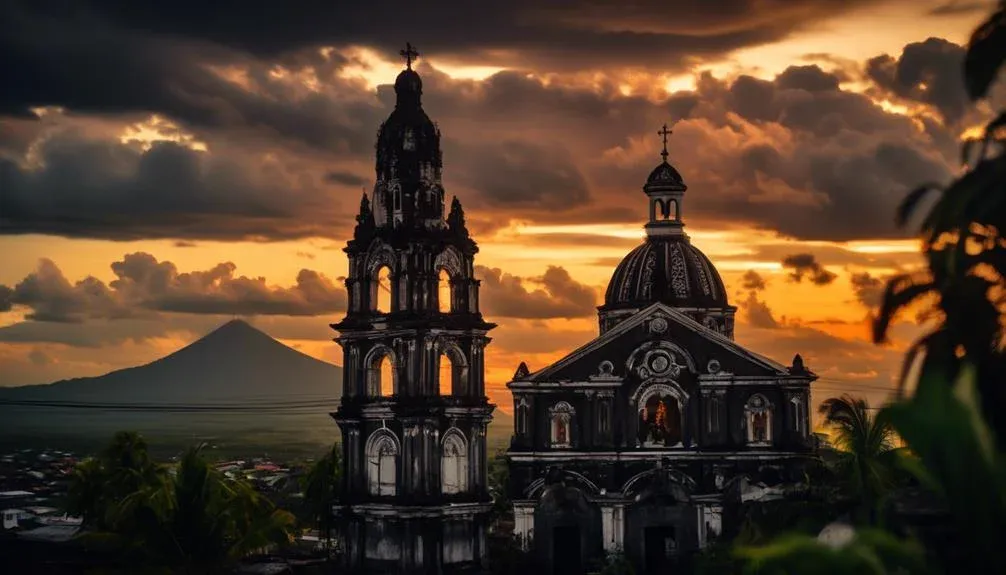
Welcome to a journey through the historic forts of the Philippines, where ancient stone walls and strategic military structures offer a tangible connection to the nation’s rich history.
From the resilient walls of Intramuros to the strategic outpost of Corregidor Island, these forts encapsulate centuries of architectural evolution and geopolitical influence in the Pacific.
Join us as we explore the unique architectural influences, cultural significance, and strategic roles of these historic forts, uncovering their enduring impact on the Filipino identity and heritage. From their original construction to their contemporary uses, these forts continue to shape the cultural and historical landscape of the Philippines.
Key Takeaways
- The Philippine defence architecture has evolved, incorporating indigenous, Spanish, American, and Japanese influences.
- Intramuros in Manila is a testament to the blending of Filipino and Spanish architectural styles and represents the resilience and evolution of Filipino culture.
- Corregidor Island’s defence played a crucial role in controlling access to Manila Bay and has witnessed significant battles throughout history.
- Fort San Pedro in Cebu and Baluarte De San Diego showcase the Spanish colonial history in the Philippines and contribute to the understanding of Filipino heritage and history.
Philippine Defense Architecture
Throughout the centuries, Philippine defence architecture has evolved significantly, reflecting the country’s strategic responses to various colonial and domestic threats. You’ll find that the colonial influence on this evolution is profound, shaping not just the physical structures but the underlying defensive tactics employed. Initially, indigenous fortifications were simple, leveraging natural terrain for defence.
However, with the arrival of Spanish colonizers in the 16th century, you see a shift towards more permanent, stone structures, designed to withstand both siege warfare and the harsh tropical climate.
These colonial-era forts, bastions, and citadels were strategically placed to guard against both foreign invaders and local uprisings, integrating European military engineering with the local landscape and materials. The defensive tactics also evolved, from passive, static defences to more active, strategic use of fortifications in the broader context of controlling and administering the islands.
You’d note that the American and Japanese occupations introduced new elements to the Philippine defence architecture, incorporating more modern fortifications and technologies. Yet, the colonial influence remains evident, with many structures still standing today as a testament to the country’s complex history of resistance and adaptation to threats.
These historical fortifications not only symbolize the strategic importance of the Philippines but also offer insight into the evolution of military defensive tactics under colonial rule.
Intramuros: Manila’s Walled City
You’ll find Intramuros, Manila’s historic heart, steeped in centuries of history, showcasing its significance as a bastion of Philippine heritage. Its walls and structures stand as testaments to architectural prowess, blending indigenous Filipino elements with colonial Spanish influences.
Today, Intramuros isn’t just a relic; it’s a vibrant community that embodies the resilience and evolution of Filipino culture through time.
Historical Significance
Nestled within the heart of Manila, Intramuros stands as a monumental testament to the Philippines’ rich colonial history, reflecting centuries of foreign influence and the resilience of its people. Its historical significance isn’t just in the remnants of structures but in the living narrative it embodies about the colonial impact and cultural heritage.
| Aspect | Impact | Example |
|---|---|---|
| Architecture | Spanish Colonial Influence | Fort Santiago |
| Governance | Establishment of Administration | Manila Cathedral as a power symbol |
| Cultural Fusion | A Blend of Local and Spanish Practices | Traditional Festivals |
Intramuscular tells a story of conquest, resilience, and evolution. It’s where you’ll find a unique blend of cultures that has shaped not just the city, but the identity of a nation. It’s a mirror reflecting the past, and through it, you’ll understand the present better.
Architectural Marvels
Stepping into Intramuros, Manila’s walled city, you’re immediately struck by its architectural splendour, a vivid testament to its historical depth and cultural amalgamation. This fortress city reflects a blend of cultural influences, evident in its unique fusion of local and colonial architecture.
The construction materials used, ranging from adobe, a volcanic tuff, to coral stone, were sourced locally, showcasing not only the area’s natural resources but also the ingenuity of its builders. Intramuros stands as a symbol of resilience, its walls having withstood wars, earthquakes, and the test of time.
The intricate design details, from the bastions to the iconic Fort Santiago, reveal a deep appreciation for both function and aesthetics, further emphasizing the city’s significance as a monumental piece of Philippine heritage.
Modern-Day Intramuros
Today’s Intramuros serves as a living museum, where the echoes of the past meet the vibrant pulse of modern Filipino life. This historic district has seamlessly integrated modern amenities while preserving its rich cultural heritage. It’s a place where you can witness the harmonious blend of history and contemporary lifestyle.
- Cultural festivals celebrate Filipino traditions, showcasing dances, music, and crafts that have survived through generations.
- Modern amenities like cozy cafés and chic boutiques are nestled within centuries-old walls, offering a unique blend of old and new.
- Guided tours provide insightful narratives of the city’s history, enhancing the visitor experience with stories of valour and resilience.
- Art exhibits and workshops thrive, highlighting the creative spirit that has long been part of Intramuros’s legacy.
Surprising Facts About The Intramuros Manila Philippines
- 🏰 Intramuros, also known as the “Walled City,” was the centre of the Spanish colonial government in the Philippines for more than 300 years.
- 🌉 The word “Intramuros” is of Latin origin and translates to “within the walls,” reflecting the city’s location within its defensive fortifications.
- 🌺 Inside Intramuros, you can find a beautiful garden called “Paco Park,” which was originally a cemetery during the Spanish colonial period. It features circular walls and a Roman Catholic chapel.
- 🚗 The streets of Intramuros are designed in a grid pattern, a departure from the typical chaotic street layouts of many other Philippine cities.
- 📚 Casa Manila, a well-preserved museum in Intramuros, replicates a Spanish colonial-era house and provides insight into the lifestyle of the elite during that period.
- 🐴 At Fort Santiago, a citadel within Intramuros, you can find a bronze statue of a carabao (water buffalo), which is a symbol of Filipino resilience and hard work.
- 🏛️ The Manila Cathedral, located in Intramuros, has been rebuilt several times due to earthquakes and wars. Its current design features a Neo-Romanesque facade and beautiful stained glass windows.
- 🌟 The Baluarte de San Diego in Intramuros is a star-shaped fort and one of the oldest stone fortifications in the Philippines, dating back to 1586.
- 🛡️ Intramuros was heavily damaged during World War II, but many efforts have been made to restore and preserve its historical buildings and structures.
- 🌆 Today, Intramuros is not only a historical site but also a vibrant cultural centre with museums, restaurants, and events that celebrate the Philippines’ rich heritage.
Fort San Pedro in Cebu
Fort San Pedro, a symbol of Spanish colonial history in Cebu, offers a glimpse into the Philippines’ rich past through its well-preserved architecture and historical significance. As you explore this historical fortress, you’re not just walking through an old structure; you’re stepping back in time.
Fort San Pedro has become a cornerstone of Cebu’s tourism, attracting visitors keen to understand the Philippines’ colonial history. However, restoration challenges have also emerged as part of its ongoing narrative. Maintaining the integrity of such a historic site, while ensuring it remains accessible and informative for tourists, requires a delicate balance.
To paint a clearer picture for you, consider the following table:
| Aspect | Details |
|---|---|
| Historical Significance | Fort San Pedro served as a military defense structure built by the Spanish in the 16th century, embodying the Philippines’ colonial past. |
| Restoration Challenges | Balancing historical authenticity with the need for modern safety and accessibility standards presents ongoing challenges. |
| Impact on Tourism | The fort is a vital part of Cebu’s tourism, offering educational and cultural insights into the Spanish colonial period in the Philippines. |
Analyzing Fort San Pedro in this manner reveals not just its role in the past, but its ongoing influence and significance in understanding Filipino heritage and history.
Surprising Facts About The Fort San Pedro in Cebu
Here are some detailed insights and intriguing facts about this fortress:
- 🏰 Historical Significance: Fort San Pedro, constructed in the 16th century by Spanish forces, is a vital remnant of the Philippines’ colonial history. It was initially built as a military defence structure, playing a key role in the Spanish occupation of the region.
- 🌍 Strategic Location: The fort’s strategic positioning in Cebu was crucial for the Spanish colonialists. It served not just as a military stronghold but also as a vantage point for monitoring incoming vessels, playing a significant part in maritime defence.
- 🛠️ Restoration Challenges: Preserving Fort San Pedro involves balancing the authenticity of its historical aspects with modern safety and accessibility standards. This has posed ongoing challenges, as efforts are made to maintain its integrity while making it a functional tourist site.
- 🌐 Impact on Tourism: Fort San Pedro is a central element of Cebu’s tourism, drawing visitors with its educational and cultural significance. It offers insights into the Spanish colonial era in the Philippines, making it a place of learning and exploration.
- 🏗️ Architectural Marvel: The architecture of Fort San Pedro reflects the Spanish colonial style, characterized by robust stone construction. Its design was aimed at withstanding sieges and the tropical climate, showcasing the ingenuity and adaptability of its builders.
- 📜 Cultural and Educational Value: The fort is not just a tourist attraction but also serves an educational purpose. It tells the story of the Philippines’ colonial past, providing a tangible connection to history for both locals and visitors.
- 🌳 Present-Day Use: Today, Fort San Pedro is a living historical site, where the past meets the present. It hosts various cultural events and activities, allowing visitors to experience a piece of Philippine history in a modern context.
- 🌉 Community Involvement: The preservation and maintenance of Fort San Pedro have involved significant community participation. This has helped to keep the fort’s history alive and fostered a sense of local pride and ownership.
- 🔍 Visitor Experience: For tourists, a visit to Fort San Pedro is both an educational journey and a step back in time. Guided tours offer stories of valour and resilience, enhancing the overall experience.
- 📚 Learning Hub: The fort also serves as an educational hub, with various programs and tours organized to teach visitors about the Philippines’ history, the importance of preservation, and the fort’s role throughout the centuries.
Corregidor Island’s Defense
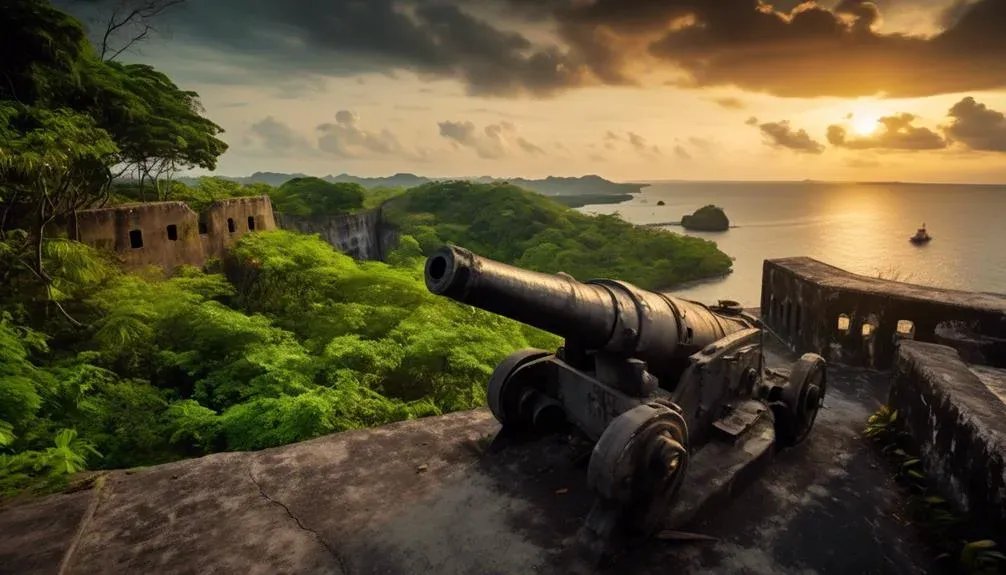
As you explore the defences of Corregidor Island, you’ll uncover its strategic military significance, nestled at the entrance of Manila Bay. This fortress played a pivotal role during World War II, serving as a formidable barrier against enemy forces aiming to penetrate the Philippines.
The impact of the conflict on Corregidor not only highlights its defensive capabilities but also marks a crucial chapter in Filipino and American military history.
Strategic Military Significance
Corregidor Island’s strategic military significance, serving as the sentinel of Manila Bay, cannot be overstated, as it played a crucial role in the defence and military operations in the Philippines throughout history. Its strategic position and fortifications reflect a blend of naval tactics and global influences, making it a focal point in military strategy.
- Geographical Advantage: Positioned at the mouth of Manila Bay, controlling access to the capital.
- Naval Defense: Utilized advanced naval tactics, deterring enemy ships and protecting trade routes.
- Global Military Influence: Adapted fortifications and defence strategies from global powers.
- Historic Battles: Witnessed significant battles, shaping the outcome of military campaigns in the region.
Surprising Facts About The Corregidor Island’s Defense
Here are some key insights and facts about Corregidor Island’s defense:
- 🏝️ Strategic Location: Corregidor Island is strategically located at the entrance of Manila Bay, making it a crucial point for controlling access to the capital city of the Philippines. Its position allowed it to serve as a formidable barrier against enemy forces.
- 🌍 Geographical Advantage: The island’s geographic positioning at the mouth of Manila Bay was pivotal for naval defence, deterring enemy ships and protecting trade routes. This made it an essential part of the defence and military operations in the Philippines.
- 🏰 Naval Defense and Global Military Influence: Corregidor Island utilized advanced naval tactics and adapted fortifications and defence strategies from global powers. This blend of naval tactics and global influences made it a focal point in military strategy.
- ⚔️ Historic Battles: Corregidor Island witnessed significant battles, particularly during World War II, which shaped the outcome of military campaigns in the region. These battles were crucial in the context of both local and global military history.
- 💥 World War II Impact: During World War II, Corregidor Island’s defence system played a critical role in the Pacific theatre. The island symbolized unyielding resistance against Axis forces, with guerrilla warfare emerging as a key tactic against the occupiers.
- 🛠️ Defense Mechanisms: The island was equipped with tunnels and artillery installations, providing a robust defence system. These installations were crucial in the island’s ability to withstand and hinder Axis operations during World War II.
- 📜 Historical Significance: The island’s role in WWII and its resilience in the face of overwhelming force have marked it as a significant chapter in Filipino and American military history. It stands as a testament to the courage and determination of its defenders.
- 🌐 Tourism and Education: Today, Corregidor Island is not only a historic site but also a destination for tourists and students. It serves as an educational site where visitors can learn about its strategic military significance and the impact of conflict on the Philippines.
- 🌉 Preservation Efforts: Efforts to preserve the historical structures and artifacts on Corregidor Island are ongoing. These efforts help to maintain the island as a living museum, honouring the bravery and resilience shown during its turbulent history.
- 🔍 Visitor Experience: A visit to Corregidor Island offers a unique blend of historical exploration and learning. Guided tours provide insights into the island’s role in World War II, its defence mechanisms, and its significance in shaping the course of Philippine history.
World War II Impact
During World War II, Corregidor Island’s defense system played a pivotal role in the Pacific theater, showcasing its resilience and strategic importance amidst intense combat operations. You’ll find that despite the overwhelming force of the Axis occupation, the island became a symbol of unyielding resistance. Guerrilla warfare emerged as a key tactic against the occupiers, underlining the ingenuity and determination of the defenders.
| Aspect | Detail | Impact |
|---|---|---|
| Strategic Location | Gateway to Manila Bay | Crucial for controlling access |
| Defense Mechanisms | Tunnels and artillery installations | Provided robust defense |
| Resistance | Guerrilla warfare | Hindered Axis operations |
This analytical look at Corregidor’s defense during World War II reveals not just the physical but also the psychological warfare at play, turning the island into a fortress of resilience against formidable odds.
Fort Pilar in Zamboanga
Nestled on the southwestern tip of the Zamboanga Peninsula, Fort Pilar stands as a testament to the Philippines’ rich colonial history, showcasing Spanish military architecture in its prime.
This fort, officially known as Real Fuerza de Nuestra Señora del Pilar de Zaragoza, has been a silent witness to the ebb and flow of Zamboanga’s vibrant life, from the era of Spanish rule through various historical milestones.
To truly appreciate Fort Pilar, consider these aspects:
- Architectural Significance: Its walls, bastions, and gateways exemplify the military engineering of the Spanish colonial period.
- Historical Role: Fort Pilar has served multiple roles: a military defence structure, a refuge during revolts and wars, and now, a regional museum.
- Cultural Impact: It’s a focal point for Zamboanga festivals, where history and local traditions blend seamlessly.
- Local Cuisine: The area around Fort Pilar offers a taste of Zamboanga’s rich culinary heritage, with dishes that have evolved over centuries.
As you explore Fort Pilar, you’re not just walking through an old fort; you’re stepping into a story that connects Zamboanga’s past with its present, offering insights into how historical fortifications have shaped local cultures and traditions.
Surprising Facts About The Fort Pilar in Zamboanga
Here are key insights and fascinating details about Fort Pilar:
- 🏰 Architectural Significance: Fort Pilar showcases the military engineering of the Spanish colonial period. Its walls, bastions, and gateways are classic examples of Spanish military architecture, reflecting the strategic design and construction techniques of that era.
- ⚔️ Historical Role: The fort has played multiple roles throughout its history. Initially, it served as a military defence structure to protect against local revolts and foreign invasions. Over time, it has also served as a refuge during wars and is now a significant regional museum.
- 🎉 Cultural Impact: Fort Pilar is more than just a historical structure; it’s a focal point for local cultural activities. The fort and its surrounding areas host various festivals where history and local traditions blend, showcasing the rich cultural tapestry of Zamboanga.
- 🍲 Local Cuisine Influence: The area around Fort Pilar offers a glimpse into Zamboanga’s culinary heritage. The local cuisine, influenced by centuries of cultural interactions and evolutions, provides visitors with a unique gastronomical experience.
- 🖼️ Modern-Day Use and Preservation: Today, Fort Pilar stands not only as a testament to the past but also as a living part of Zamboanga’s present. It engages in cultural and educational programs, making history accessible and relevant to contemporary audiences.
- 🌐 Educational Role: The fort educates visitors about the colonial dynamics, trade relations, and resistance movements that have shaped the region’s history. Through exhibitions and interactive tours, it connects Zamboanga’s past with its present.
- 🔍 Visitor Experience: Exploring Fort Pilar is a journey through time. Visitors can walk through the fort’s ancient corridors, experiencing the blend of historical narrative and modern interpretation.
- 🎭 Community Involvement: The fort is a symbol of community pride and identity in Zamboanga. Local involvement in its maintenance and promotion is significant, ensuring the fort remains a vibrant part of the community.
- 🌿 Natural Setting: The fort’s location also offers a scenic view, combining historical architecture with natural beauty. It provides a serene environment for both reflection on the past and enjoyment of the present.
- 📚 Preservation Efforts: Ongoing efforts to preserve Fort Pilar involve local and international cooperation. These efforts ensure the fort remains an enduring symbol of the region’s history and cultural heritage.
The Structure of Fort Santiago

Situated in the heart of Manila, Fort Santiago stands as a pivotal monument, reflecting the Philippines’ tumultuous history through its resilient structure and strategic design. This fortress isn’t just a relic; it’s a living narrative, woven from centuries of events that have shaped the nation.
Its walls, once witnesses to battles and declarations, now embrace a different role. They’ve become event venues, hosting cultural and social gatherings that bridge the past with the present.
However, it’s not just the tangible that intrigues visitors. Fort Santiago is shrouded in ghost stories, adding a layer of mystique to its historical significance. It’s said that at night, the echoes of the past come alive, whispering tales of heroism and tragedy.
| Feature | Description |
|---|---|
| Bastions | The fort’s corners, equipped for defense, offer a glimpse into strategic military architecture. |
| Rizal Shrine | A tribute to the national hero Dr. Jose Rizal, marking his final steps before execution. |
| Dungeons | Once a grim site of imprisonment, now a solemn reminder of the fort’s darker chapters. |
| Plaza Moriones | A versatile open space, often transforming into an event venue amidst a historical backdrop. |
Fort Santiago’s structure, steeped in history, serves as a canvas for both celebration and remembrance, making it an enduring symbol of the Filipino spirit.
Surprising Facts About The Fort Santiago Philippines
Here are key insights and interesting facts about Fort Santiago:
- 🏰 Historical Significance: Fort Santiago is a citadel first built by Spanish conquistador Miguel López de Legazpi. The fort is part of the structures of the walled city of Intramuros in Manila and has been a witness to the history of the Philippines, from the Spanish colonial period through World War II and beyond.
- ⚔️ Role in Philippine History: Fort Santiago is known for its crucial role in Philippine history, especially during the Spanish colonial period. It served as a key defensive fortress and was a significant site during the Philippine Revolution against Spanish rule.
- 📜 Dr. Jose Rizal’s Imprisonment: One of the most notable historical events associated with Fort Santiago is the imprisonment of Dr. Jose Rizal, the Philippines’ national hero. Rizal was detained here before his execution in 1896. His cell and the footsteps representing his final walk to his execution site are important historical markers.
- 🌟 Architecture and Design: The fort showcases Spanish military architecture, with its high walls, gates, and bulwarks designed to protect the city from foreign invasions. The design reflects the military strategy and architectural style of the Spanish era.
- 💥 Damage and Restoration: Fort Santiago suffered significant damage during World War II, particularly during the Battle of Manila. It has since been restored and is now a popular tourist destination, preserving its historical value.
- 🎭 Cultural Venue: Today, Fort Santiago is not only a historical site but also a cultural venue. It hosts various events, including theatre productions, concerts, and festivals, blending history with contemporary Filipino culture.
- 🌿 Rizal Shrine: The Rizal Shrine in Fort Santiago is dedicated to the life and works of Jose Rizal. The museum displays memorabilia of the hero, including manuscripts, photographs, and personal belongings, providing insights into his life and the movement for Philippine independence.
- 🌐 Tourism and Education: Fort Santiago is a prime tourist attraction in Manila, offering guided tours that highlight its historical importance. Educational programs are also conducted here, making it a place of learning and cultural exchange.
- 🌉 Accessibility and Preservation: Efforts have been made to maintain and preserve Fort Santiago, ensuring it remains accessible to the public. These efforts include maintaining the structural integrity of the fort and providing informative materials for visitors.
- 🔍 Visitor Experience: A visit to Fort Santiago offers a rich educational experience, allowing visitors to walk through the history of the Philippines. The site serves as a powerful reminder of the country’s colonial past, its struggle for independence, and the enduring spirit of its people.
Fort San Felipe’s Marvel
Fort San Felipe stands as a testament to the Philippines’ rich military heritage, showcasing an architectural prowess that has withstood the test of time. As you delve deeper into its story, you’ll find that its significance stretches beyond its formidable walls, particularly in the realms of naval history and cannon technology.
- Strategic Location: Perched strategically at the mouth of Manila Bay, Fort San Felipe was pivotal in controlling access to the Philippines, underscoring its role in naval history.
- Advanced Cannon Technology: The fort was armed with state-of-the-art cannons for its time, designed to repel invasions and protect the nation’s sovereignty.
- Architectural Design: Its design reflects a blend of local and Spanish military architecture, optimizing both defense capabilities and the use of local materials.
- Historical Battles: It served as a crucial battleground in several significant conflicts, each shaping the course of Philippine history and demonstrating the evolution of military tactics and technology.
Analyzing Fort San Felipe’s marvel involves appreciating its contribution to naval defence and the advancement in cannon technology. Its legacy is not just in the battles it withstood, but in the innovations and strategies that were born within its walls.
Surprising Facts About The Fort San Felipe’s Marvel
- 🏰 Fort San Felipe, located in Cavite City, Philippines, was originally built by Spanish conquistadors in the 16th century as a defence against pirates and invaders.
- 🌊 This historical fortress faces the scenic Manila Bay, offering a strategic vantage point for monitoring incoming ships during the colonial era.
- 🇪🇸 The fort’s name, “San Felipe,” is in honour of King Philip II of Spain, under whose reign the Philippines was a colonial territory.
- 💣 During World War II, Fort San Felipe served as a key location for the defence of Manila Bay against Japanese forces.
- 🔍 The fort’s design and architecture reflect the Spanish military engineering of the time, with thick walls and strategic positioning for artillery.
- 📚 Fort San Felipe once housed the Philippine Naval Academy, playing a pivotal role in the training and education of the country’s naval officers.
- 🌱 Today, the fort is surrounded by a lush garden, making it a popular spot for both history enthusiasts and nature lovers.
- 🎭 The fortress has been a backdrop for several Filipino historical films and television series, showcasing its cultural significance.
- 🏗 In various periods of its existence, Fort San Felipe has undergone several renovations and restorations to preserve its historical integrity.
- 📜 The fort holds a museum that displays artifacts, documents, and other items significant to Philippine naval history, offering a glimpse into the country’s colonial past.
Fuerza De Capul’s Bastion

As you explore Fuerza De Capul’s Bastion, you’ll find its historical significance not only in its past roles but also in the stories etched within its walls. Its architectural design features offer a glimpse into the ingenuity and strategic mindset of its creators, reflecting a blend of local and colonial influences.
The conservation efforts today highlight a commitment to preserving this gem for future generations, underscoring its enduring legacy in Filipino heritage.
Historical Significance
Every brick of Fuerza De Capul’s Bastion whispers tales of historical significance, embodying a rich past that has shaped the cultural and military landscape of the Philippines. This bastion serves as a living testament to the resilience and strategic ingenuity of its builders, revealing the layers of history that have contributed to the nation’s identity.
- Cultural influences: The architecture reflects a blend of indigenous and colonial design principles, showcasing the fusion of various cultural influences.
- Colonial impacts: It stands as a symbol of the colonial era’s challenges and the Filipinos’ enduring spirit amidst foreign domination.
- Strategic importance: Positioned as a crucial maritime route, it highlights the military significance of protecting and controlling the surrounding waters.
- Preservation efforts: Current initiatives underscore its value as a historical treasure, promoting awareness and conservation.
Architectural Design Features
Building on its rich historical context, Fuerza De Capul’s Bastion reveals architectural design features that are as strategic as they are aesthetic, offering insight into the ingenuity of its constructors.
| Feature | Description | Significance |
|---|---|---|
| Material Techniques | Utilized coral stone and lime for construction durability. | Enhanced structural integrity |
| Defensive Walls | Thick, high walls with watchtowers at strategic points. | Provided robust defense |
| Decorative Elements | Intricately carved reliefs on the bastion’s facade. | Embodied cultural identity |
| Entryways | Arched gateways with wooden doors reinforced with iron. | Balanced security and access |
| Ventilation Systems | Small, strategically placed windows for airflow. | Ensured comfort and health |
These elements showcase how Fuerza De Capul balanced functionality with form, employing material techniques and decorative elements to create a fortification that was as beautiful as it was formidable.
Conservation Efforts Today
How are current conservation efforts ensuring the preservation and longevity of Fuerza De Capul’s Bastion, given its historical significance and unique architectural features? Today’s efforts are multifaceted, combining traditional and innovative approaches to safeguard this precious site for future generations.
- Public Awareness Campaigns: Elevating the fort’s profile through education and social media to foster a sense of communal responsibility.
- Funding Strategies: Securing grants and donations from both local and international sources to finance restoration projects.
- Partnerships with Heritage Organizations: Collaborating with experts for technical guidance and support.
- Regular Maintenance and Surveillance: Implementing a consistent care schedule and monitoring the site to prevent deterioration.
These strategies are crucial in confronting the challenges of conservation, ensuring that Fuerza De Capul’s Bastion remains not just a relic of the past, but a living testament to Filipino heritage.
Surprising Facts About The Fuerza De Capul’s Bastion Philippines
- 🏰 Fuerza De Capul’s Bastion, with its historical significance, serves as a living testament to the resilience and strategic ingenuity of its builders, reflecting the layers of history that have contributed to the Philippines’ identity.
- 🌐 The architectural design of Fuerza De Capul’s Bastion reflects a blend of indigenous and colonial influences, showcasing the fusion of various cultural elements in its construction.
- ⚔️ The bastion stands as a symbol of the challenges of the colonial era and the enduring spirit of the Filipino people amidst foreign domination.
- 🚢 Its strategic importance is highlighted by its position along a crucial maritime route, underlining the military significance of protecting and controlling the surrounding waters.
- 🛠️ Current preservation efforts emphasize the bastion’s value as a historical treasure, promoting awareness and conservation to maintain its legacy.
- 🎨 The architectural design features of Fuerza De Capul’s Bastion include the use of coral stone and lime for construction, thick defensive walls with watchtowers, and intricately carved reliefs on the facade.
- 🌿 The arched gateways and wooden doors reinforced with iron in the bastion balance security and accessibility, while small windows strategically placed allow for airflow.
- 📚 Today’s conservation efforts for Fuerza De Capul’s Bastion are multifaceted, combining public awareness campaigns, funding strategies, partnerships with heritage organizations, and regular maintenance.
- 🌐 Community involvement in the preservation of the bastion is significant, fostering a sense of local pride and ownership in this historical site.
- 🔍 Visitors to Fuerza De Capul’s Bastion can experience a journey through time, exploring the fort’s ancient corridors and experiencing the blend of historical narrative and modern interpretation.
Fort Santa Isabel’s Role
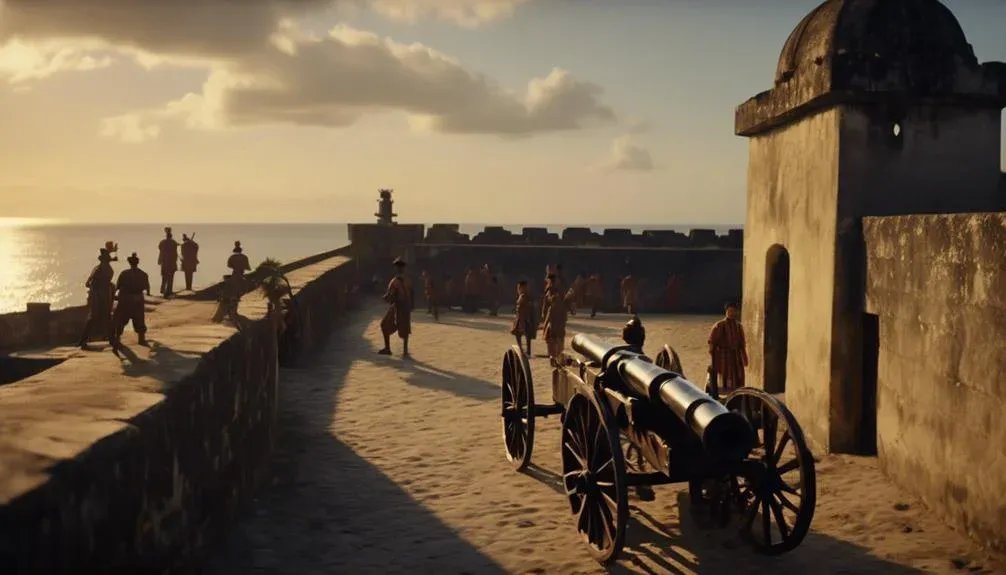
Fort Santa Isabel played a pivotal role in the Philippines’ colonial history, serving as a key defensive structure that safeguarded the strategic interests of its colonizers. Beyond its military significance, the fort emerged as a cultural beacon, intricately woven into the societal fabric of its locale. Today, it’s not just an echo of the past but a living museum, actively engaging in cultural festivals and educational programs. These initiatives serve as bridges, connecting generations to their rich heritage while fostering a deeper understanding of the fort’s historical significance.
As you delve deeper, you’ll find that Fort Santa Isabel’s architectural prowess was matched by its strategic location, overseeing vital sea routes that were crucial for trade and defence. Its walls, which once echoed with the sounds of cannon fire, now resonate with the voices of educators and historians, eager to share its stories.
In essence, Fort Santa Isabel’s role has evolved from a bastion of colonial might to a centre of cultural and educational enlightenment. It stands as a testament to the resilience of Filipino heritage, inviting you to explore its corridors and learn from its storied past.
Surprising Facts About The Fort Santa Isabel Philippines
- 🏰 Fort Santa Isabel, officially known as Real Fuerza de Nuestra Señora del Pilar de Zaragoza, is a significant historical site in Zamboanga, Philippines, showcasing the Spanish military architecture of its time.
- ⚔️ Historically, the fort served multiple purposes: it was a military defense structure against local revolts and foreign invasions, a refuge during wars, and now functions as a regional museum.
- 🎉 The fort is a cultural hub in Zamboanga, hosting various festivals where history and local traditions blend, reflecting the rich cultural tapestry of the region.
- 🍲 The area around Fort Santa Isabel is known for its culinary heritage, offering a taste of Zamboanga’s diverse and evolved local cuisine.
- 🖼️ Today, Fort Santa Isabel is not only a historical monument but also an active participant in cultural and educational programs, making history accessible to contemporary audiences.
- 🌐 The fort plays an educational role, informing visitors about the colonial dynamics, trade relations, and resistance movements that have shaped the region’s history.
- 🔍 Touring Fort Santa Isabel offers a unique journey through time, where visitors can experience the blend of historical narrative and modern interpretation.
- 🎭 The fort symbolizes community pride and identity in Zamboanga, with significant local involvement in its maintenance and promotion.
- 🌿 Fort Santa Isabel’s location offers scenic views, combining historical architecture with natural beauty, providing a serene environment for reflection and enjoyment.
- 📚 Preservation efforts for Fort Santa Isabel involve local and international cooperation, ensuring the fort remains an enduring symbol of the region’s history and cultural heritage.
Fort San Andres’ Defense
While Fort Santa Isabel offers a window into the cultural and educational aspects of the Philippines’ colonial past, Fort San Andres stands as a stark reminder of the military prowess and strategic importance that forts held in safeguarding the nation’s shores. Nestled strategically, it played a crucial role in the defence against invaders, utilizing the advanced naval tactics of its time.
- Strategic Location: Fort San Andres was ingeniously constructed on elevated ground, providing a panoramic view of the approaching enemy ships, which allowed for early detection and preparation.
- Naval Tactics: The fort’s design incorporated features for naval warfare, including cannon placements that maximized the field of fire over the water. This made it a formidable challenge for enemy ships attempting to breach the harbour.
- Local Folklore: Stories and legends embellish its history, with tales of heroic battles and ingenious defence strategies that have been passed down through generations, enriching the fort’s legacy.
- Architectural Design: Its architecture was not just for defence; it also reflected the adaptability of the fort to the tropical climate, ensuring that the garrison could withstand long sieges if necessary.
Analyzing Fort San Andres’ defence mechanisms sheds light on the sophisticated military strategies and the cultural resilience embedded in the Philippines’ history.
Surprising Facts About The Fort San Andres Philippines
- 🏰 Fort San Andres, located in the Philippines, represents a historical landmark that played a significant role in the nation’s defence against invaders, showcasing the military prowess and strategic importance of forts in Philippine history.
- 🌊 Strategically constructed on elevated ground, Fort San Andres provided a panoramic view of approaching enemy ships, allowing for early detection and preparation, demonstrating the strategic military thinking of the time.
- ⚔️ The fort’s design incorporated advanced naval tactics, with cannon placements maximizing the field of fire over the water, making it a formidable barrier for enemy ships attempting to breach the harbour.
- 📜 Fort San Andres is also steeped in local folklore, with stories of heroic battles and ingenious defence strategies that have been passed down through generations, enriching the fort’s legacy and cultural significance.
- 🌞 The architectural design of the fort reflected adaptability to the tropical climate, ensuring that the garrison could withstand long sieges and harsh environmental conditions.
- 🏛️ The fort’s architecture and design were not only functional for defence but also a representation of the colonial era’s architectural styles, blending practical military needs with aesthetic considerations.
- 🌱 Today, Fort San Andres continues to be a point of interest for history enthusiasts and tourists, offering a glimpse into the Philippines’ rich military history and the evolution of military tactics and architecture.
- 🎭 The fort’s preservation and presentation to the public play a crucial role in educating about the Philippines’ historical battles, conflicts, and the strategic importance of such military installations.
- 🌐 Fort San Andres serves as a symbol of the cultural resilience embedded in the Philippines’ history, showcasing the country’s long-standing tradition of fortification and defence against external threats.
- 🔍 Visitors to Fort San Andres can engage in a journey through time, exploring the fort’s well-preserved structure and learning about its significant role in the nation’s history, from a defensive stronghold to a cultural icon.
Fort Ilocandia: Northern Sentinel
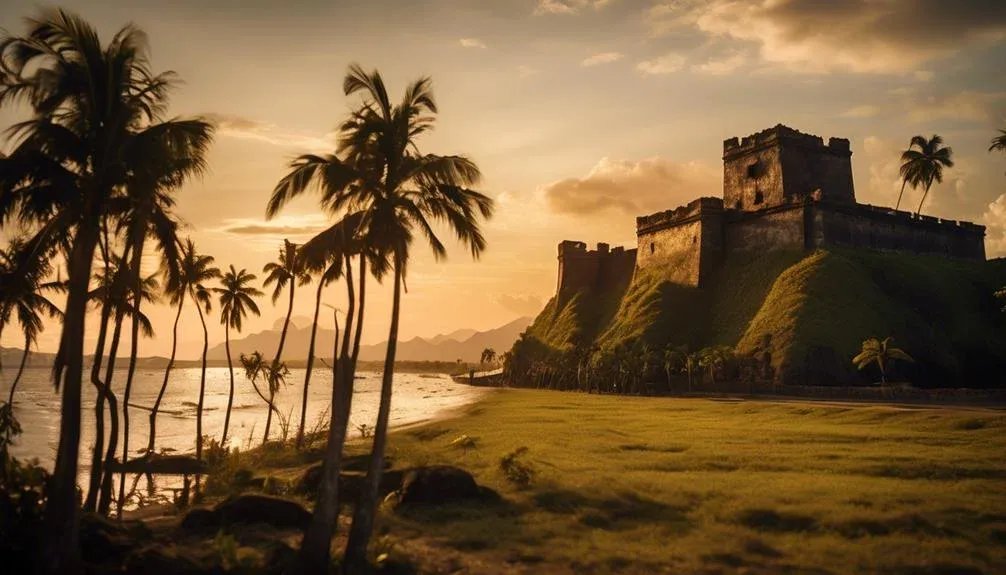
Standing as a testament to the resilience and strategic foresight of its builders, Fort Ilocandia’s history is deeply intertwined with the narratives of the northern Philippines’ defence against colonial powers. This formidable structure wasn’t just a military installation; it was a cornerstone for the development of the region, playing a pivotal role in both safeguarding and shaping the cultural landscape.
You’ll find that Fort Ilocandia’s significance extends beyond its historical military importance. It has been a catalyst for tourism development in the region, attracting visitors not only with its historical allure but also with the rich tapestry of Ilocos cuisine. The fort’s surroundings have become a vibrant showcase of the area’s culinary heritage, offering an immersive experience that blends historical exploration with gastronomical adventure.
Moreover, the strategic position of Fort Ilocandia facilitated interactions that have enriched Ilocos cuisine, incorporating diverse influences while retaining its unique flavours. This blend of history and culinary excellence has propelled the region into a prominent position on the map of Philippine tourism, demonstrating how heritage sites can pivot towards becoming hubs of cultural and economic activity.
Surprising Facts About The Fort Ilocandia Philippines
Here are 10 lesser-known yet fascinating facts about this landmark:
- 🏰 Fort Ilocandia was originally built as the “Marcos Mansion,” intended to be the residence of former President Ferdinand Marcos.
- 🌊 Situated in Laoag, Ilocos Norte, the resort is the only 5-star hotel in Northern Luzon and is renowned for its unique Spanish colonial architecture.
- 🛬 The Fort has its airstrip, which was used primarily to accommodate private planes of VIP guests during its early years.
- 🎬 It has been a favourite shooting location for several films, including local and international productions, due to its picturesque setting.
- 🌴 The resort is set on 77 hectares of land, featuring expansive gardens, a lagoon, and various outdoor amenities.
- 🎰 Fort Ilocandia has a casino, which was one of the major attractions when it first opened, appealing to both local and international visitors.
- 🌐 During its peak, the resort was a popular destination for heads of state, dignitaries, and celebrities from around the world.
- 🏌️♂️ It boasts an 18-hole golf course, designed to international standards, which attracts golf enthusiasts from various regions.
- 🏞️ The property is close to the famous Paoay Sand Dunes, offering guests unique recreational activities like sandboarding and 4×4 rides.
- 🌅 The resort’s location provides spectacular views of the South China Sea, making it a sought-after location for romantic getaways and picturesque weddings.
Preserving Fort San Antonio Abad
Just as Fort Ilocandia has been a beacon of cultural preservation and tourism, so too has Fort San Antonio Abad played a crucial role in the conservation of Philippine history and heritage. The preservation of this historic fort is a testament to the dedication and hard work of various stakeholders, including local communities and preservation experts.
Here’s how the preservation of Fort San Antonio Abad has been approached:
- Utilization of Advanced Art Restoration Techniques: Experts have employed state-of-the-art methods to restore the fort’s intricate details, ensuring that both structural integrity and historical accuracy are maintained.
- Community Involvement: Local communities have been actively involved in the preservation process, contributing not only to the physical labour required but also to keeping the spirit and stories of the fort alive.
- Regular Maintenance and Surveillance: To prevent decay and vandalism, regular maintenance schedules are strictly followed, coupled with surveillance systems to protect the site.
- Educational Programs and Tours: By organizing tours and educational programs, the fort serves as a live classroom, teaching visitors about Philippine history and the importance of preserving such sites.
Through these efforts, Fort San Antonio Abad continues to stand as a symbol of Philippine resilience and history, bridging the past with the present.
Surprising Facts About The Fort San Antonio Abad Philippines
- 🌍 Fort San Antonio Abad is not only a historical site but also houses the Metropolitan Museum of Manila, blending history with art.
- ⚔️ Originally built in 1584, the fort served as a defence structure against foreign invasions, particularly from pirates and invaders.
- 🔥 The fort was destroyed by fire in 1583 and subsequently rebuilt, showcasing its resilience and importance in Philippine history.
- 🛠️ The reconstruction of Fort San Antonio Abad in the late 16th century featured an innovative design, utilizing volcanic tuff, a locally sourced material, making it a unique example of adaptive architecture.
- 💣 During World War II, the fort played a strategic role and suffered significant damage during the Battle of Manila in 1945.
- 🖼️ After extensive restoration, the fort transitioned to a cultural venue in 1976, underscoring its adaptability and cultural significance.
- 🌱 The fort’s surroundings have been transformed over the centuries, from a strategic military location to a thriving urban area, reflecting Manila’s dynamic urban development.
- 📚 Fort San Antonio Abad has been a silent witness to key historical events in the Philippines, from the Spanish colonial period to contemporary times, making it a living history book.
- 🎨 The Metropolitan Museum of Manila, located within the fort, is known for its focus on contemporary art, especially works by Filipino artists, bridging the past and present.
- 🕊️ Today, the fort symbolizes peace and resilience, standing as a testament to the Philippines’ rich and diverse history, blending the old with the new in Manila’s vibrant landscape.
Baluarte De San Diego
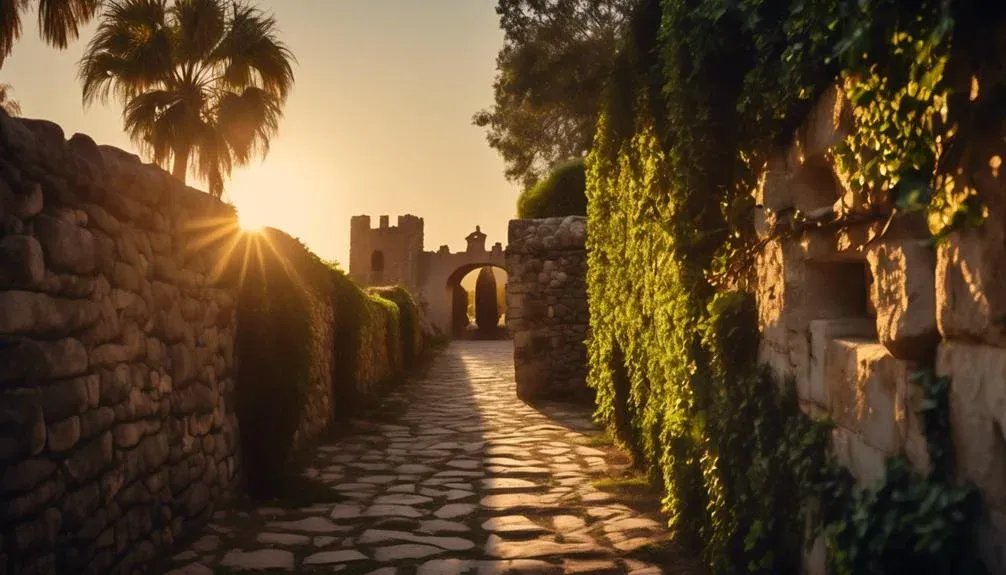
Nestled in the heart of Manila, Baluarte De San Diego offers a fascinating glimpse into the Philippines’ colonial past, showcasing its strategic importance and architectural prowess. This historic structure, originally designed for defence, has undergone significant transformations, notably in its gardens’ restoration. The meticulous rejuvenation of these gardens not only enhances the fort’s aesthetic appeal but also serves as a testament to the enduring legacy of Spanish colonial architecture in the Philippines.
The restoration process involved careful planning and execution, ensuring that the revived gardens accurately reflect the period’s landscaping styles. This attention to detail has transformed Baluarte De San Diego into a living museum, where visitors can immerse themselves in history amidst lush greenery.
Community engagement has been pivotal in the fort’s preservation efforts. Local initiatives have fostered a sense of ownership and pride among residents, encouraging them to participate actively in the site’s maintenance and promotion. This collaborative approach has not only contributed to the fort’s physical upkeep but has also helped in educating the public about the significance of preserving historical landmarks.
Surprising Facts About The Baluarte De San Diego Philippines
- 🌿 Baluarte De San Diego in Manila is a star-shaped fort, one of the oldest stone fortifications in the Philippines, originally constructed in 1586.
- 🏛️ The fort was part of the defensive structures of the walled city of Intramuros, designed to protect Manila from foreign invasions and local uprisings.
- 🛠️ Baluarte De San Diego showcases Spanish military architecture with its robust stone construction, demonstrating the strategic design and construction techniques of the era.
- 🌸 The fort is renowned for its beautifully restored gardens, which are a popular attraction for both tourists and locals, offering a serene escape amidst historical surroundings.
- 💥 It suffered significant damage during World War II but has since been restored to preserve its historical value and beauty.
- 🎨 Today, Baluarte De San Diego serves not just as a historical site but also as a venue for various cultural events, exhibitions, and artistic endeavours.
- 📚 The fort’s restoration process involved meticulous planning to ensure that the revived gardens and structure accurately reflect the historical and architectural integrity of the period.
- 🌐 The restoration and maintenance of Baluarte De San Diego have involved significant community participation, fostering a sense of local pride and ownership in this historical site.
- 🌳 The fort’s location in the heart of Manila makes it an accessible cultural landmark, where history and contemporary Filipino life intersect.
- 🔍 Visitors to Baluarte De San Diego can engage in a journey through time, exploring the fort’s ancient structure and lush gardens, and learning about its significant role in the history of Manila and the Philippines.
Frequently Asked Questions
What Are the Unique Architectural Influences Seen in Filipino Forts That Differentiate Them From Other Colonial Fortifications Around the World?
You’ll find Filipino forts uniquely blending European designs with Islamic motifs, setting them apart from other colonial fortifications. This mix reflects diverse cultural influences, offering a distinct architectural perspective not seen in similar structures worldwide.
How Have Local Myths and Legends Shaped the Cultural Significance of These Historic Filipino Forts Throughout the Years?
Local myths and legends, including ghost stories and encounters with mythical creatures, have deeply influenced the cultural significance of these forts. They’ve shaped perceptions, adding layers of mystery and cultural depth over the years.
Can You Detail the Role of Indigenous Filipino Building Techniques and Materials in the Original Construction and Later Restoration Efforts of These Forts?
Indigenous Filipino building techniques and materials played a pivotal role in both the original construction and later restoration of these forts, integrating modern construction methods and sustainability practices to preserve their historical and cultural integrity.
How Did the Strategic Locations of These Forts Influence the Outcomes of Historical Battles and Conflicts in the Philippines?
The strategic locations of these forts significantly influenced historical battles in the Philippines, shaping naval strategies and economic impacts. Their placements not only deterred enemies but also controlled vital trade routes, affecting the region’s prosperity.
Are There Any Contemporary Uses or Adaptations of These Historic Forts in the Philippines That Blend Their Historical Significance With Modern-Day Functions?
You’ll find that these forts now host modern events and art exhibitions, blending their historical roots with contemporary functions. This adaptation showcases a seamless integration of the past and present, enriching their cultural significance.
Conclusion
In conclusion, the historic forts of the Philippines are far more than mere monuments. They stand as vibrant emblems of the nation’s diverse history, resilience, and cultural integration. Ranging from Intramuros’ ancient walls to Corregidor Island’s strategic outpost, these forts tell a compelling story of the Philippines’ evolution through periods of colonial rule and conflict to its current sovereign state.
These structures are a unique blend of European and local architectural styles, reflecting a rich fusion of cultural influences. Their strategic locations were crucial in historical conflicts, shaping the nation’s fate. Today, these forts have transitioned into cultural centers, hosting events and educational programs, thus weaving their historical relevance into the fabric of modern life.

